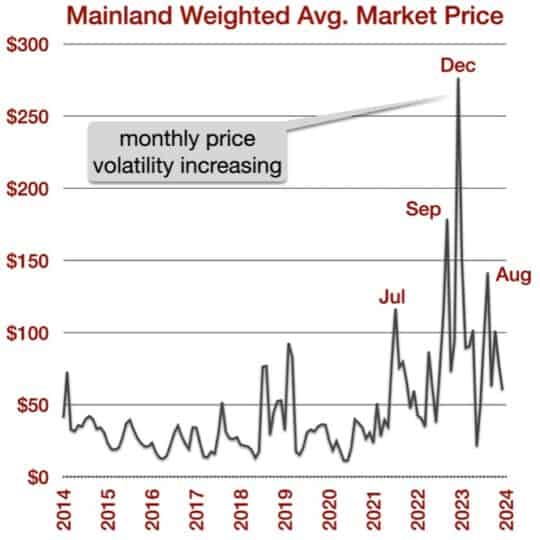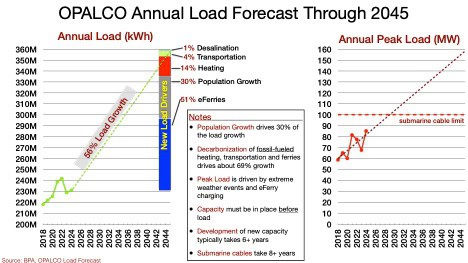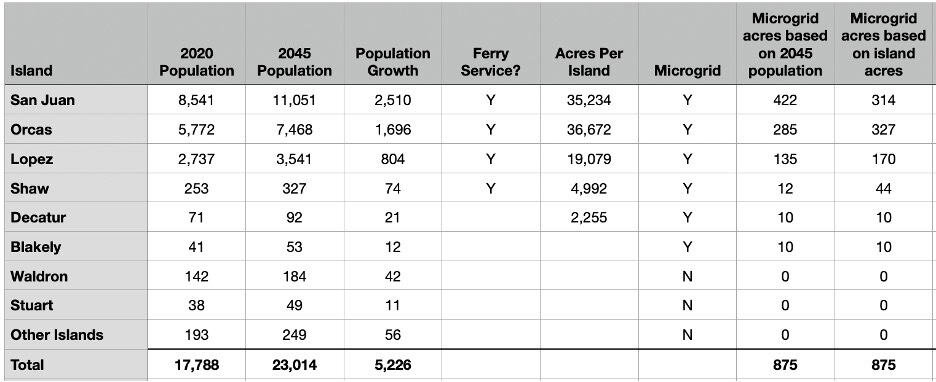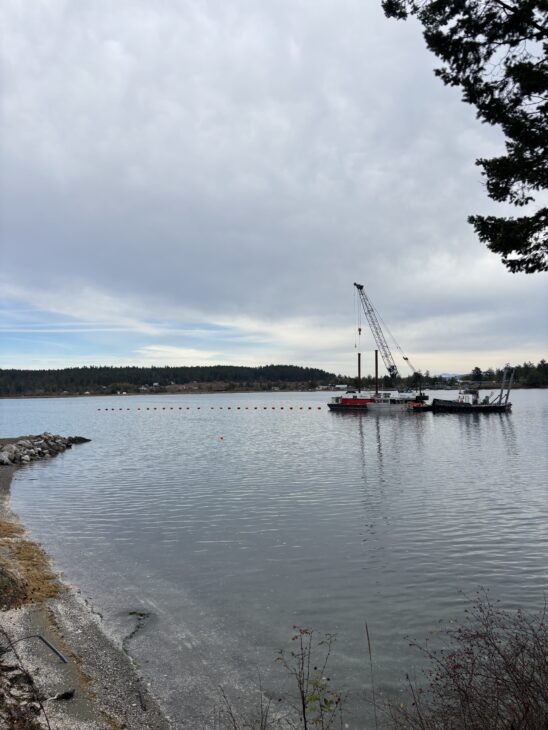Quick Fact: Local Energy Forecast
San Juan County’s Comprehensive Plan (Comp Plan) calls for reducing our dependence on the mainland with local renewable energy. Throughout this document, OPALCO is using the Comp Plan to forecast our future energy needs.
- The cost of electricity on the mainland is outpacing inflation, particularly during extreme weather events.
 The probability of mainland power outages and spikes in wholesale power costs has been growing exponentially as mainland energy consumption outpaces supply (see chart to the right).
The probability of mainland power outages and spikes in wholesale power costs has been growing exponentially as mainland energy consumption outpaces supply (see chart to the right).- Wholesale electricity prices on the mainland have surged by over 800 percent during recent summer heat waves and winter cold snaps.
- Extended outages can cost the local economy millions per day.
- Mainland outages particularly hurt vulnerable members of our community.
- According to the Comp Plan, over the next twenty years, county energy demand is projected to increase by more than 50%. That would require a third submarine cable to the mainland, which would cost over $100 million, comparable to the value of all OPALCO’s current infrastructure. And there are no grants to help pay for that. A recent Snohomish PUD rate case suggested this would increase our total mainland power bill by 600%.
Load Forecast
There is no new hydroelectricity on the mainland to meet the rapidly increasing demand, and new mainland renewable energy projects are not being approved quickly enough.
Just like the mainland, our local energy needs are growing rapidly. The chart below shows our current and projected local energy consumption (left) and peak demand (right) based on numbers outlined in the Comp Plan.

There are several essential things worth noting:
- County population growth and their heating and transportation accounts for about half of the new energy growth.
- The other half of the projected load growth comes from replacing the diesel ferries with new eFerries. The diesel ferries are one of the largest sources of county pollution.
- Peak Load refers to the highest power usage that occurs over a short period, typically an hour, usually during extreme cold weather.
- While annual load (kWh) tells you how much energy is used, peak load tells you how fast customers draw it at once. Utilities build infrastructure to meet this peak, not just the average. Microgrid storage helps “shave” the peaks to avoid system overload and extreme mainland demand charges.
- Local peak energy demand is projected to exceed the mainland submarine cable limit around 2030.
- Local energy generation reduces the impact of mainland energy price shocks and outages, helping co-op members save money and keep the lights (and heat) on.
- Developing local renewable energy projects takes time. Permit approval has been taking years for each project.
Local Projects
Each island can play its part in ensuring we generate enough affordable, clean, quiet local energy to meet new load, mitigate mainland price shocks, defer the need for a submarine cable, and provide local energy for critical services during extended mainland power outages. It takes about 1% of each island’s land to host utility-scale solar and storage microgrids.
Rooftop solar has a helpful role to play, but it is projected to account for less than 5% of total energy consumption. They are expensive, shifting costs to non-solar members. The bulk of local energy will come from utility-scale microgrids. A microgrid has the following benefits:
- They help cap the cost of electricity from the mainland, protecting islanders from mainland price gouging during extreme weather events in summer and winter.
- They can be deployed in cooperation with farmers to help them enhance their food production, improve soil fertility, and optimize their farming economics. This “agrisolar” application is being used worldwide to harness the sun for food and energy.
- Microgrid energy storage can be used to mitigate peak demand during cold snaps, thereby protecting submarine cables from damage and avoiding costly mainland peak demand charges during these periods.
With each island working together we can meet this challenge. The table below shows the number of acres of microgrid needed to support the six largest island populations. For the smaller of those islands, note that a minimum microgrid requires about 10 acres for solar, energy storage, infrastructure, and substation systems.

Learn More
Comprehensive Plan Material Utility Element From OPALCO
WA 2021 Energy Strategy and Implications
Decarbonization will reduce TOTAL energy consumption by 28%, by nearly doubling demand for electricity
Shortfall starts this year, growing to 25,000 MW deficit by 2035, Northwest needs to be adding 2,500 MW per year – 25 X faster than normal
OPALCO Energy Trend Graphs and Charts







